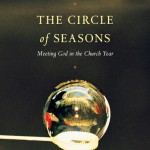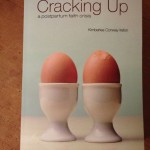As I was heading out the door to take my husband to the train station, I grabbed my cell phone. Immediately a cascade of anxiety washed through my body and with it the remembrance that a friend was angry with me. I stared at the phone in my hand, remembering our interaction the night before.
In years past, I would have fallen asleep with that phone conversation gnawing at me, replaying it over and over again in my head, and I would have woken up with it weighing on my chest. I am a people pleaser, highly sensitive to other people’s responses to me, and I do not like friction in my relationships. Of all causes of anxiety, relational friction (whether real or perceived) has always been the most common for me. But I’ve experienced so much healing from anxiety in the past two years that it wasn’t until I picked up the phone that I even remembered about that unpleasant situation, and by the time I’d dropped my husband off at the train and was headed home—a mere ten minutes—I was fine. The anxiety was gone.
*****
Three years ago, I found myself directing my homeschool co-op. I had zero leadership experience, and I realized pretty quickly that if I didn’t want to fall flat on my face or ruin the co-op and my relationships there, I was going to need some help. So I turned where I always turn when I need advice or encouragement or wisdom: to books. The book that matters for our purposes here is 7 Habits of Highly Effective People by Stephen Covey, which I’d read in my 20’s and which still sat on my shelf. Re-reading it in my late 30’s created a paradigm shift from which all the other habits I’ll discuss fairly quickly cascaded.
Covey’s first habit is “Be Proactive.” Part of that chapter is a discussion of Viktor Frankl’s discovery in a German concentration camp that in a dire situation in which he was cruelly and brutally mistreated, abused, and even tortured, he still had control over one very important thing: himself.
Reading Frankl, I was reminded of an old Buddhist story I’d heard in grad school about an army general bursting into a monastery and finding an old Zen master sitting calmly on a rock in the garden. The master remained unperturbed as the sword-wielding general advanced. “Why aren’t you afraid?” the general demanded as he sliced his sword through the air. “Don’t you know who I am? I’m the man who can cut off your head!”
“Yes,” the Zen master replied. “And I’m the man who can let you.”
At the time I both marveled at and was appalled by the story. But it’s a story similar to Jesus’s—He Himself said He could call down a legion of angels to deliver Him, but instead He let the Romans crucify Him. His choice was harder than the Zen master’s—He had power to fight back and win, and He chose instead to submit to what looked like loss and suffer all that entailed.
How, I wondered, reading Frankl’s words again, how do you get to be like that?
Covey, following Frankl (and countless others), insisted that there was a gap between stimulus and response, that you could choose how to respond. This was not new to me. For years—decades, even—I had been told, “You can’t control what happens to you. You can only control how you respond to what happens to you.” And while I acknowledged the theoretical truth of that claim, my understanding remained only that: theoretical. I had little, if any, experiential understanding. It seemed to me that I was already responding before I ever had a chance to choose how I would respond.
When I picked up my phone that morning, anxiety flooded my body before I could even think about choosing a response. So how exactly did one access that supposed gap between stimulus and response? For me there was no gap. The stimulus and my response to it were simultaneous.
And then it dawned on me: I wasn’t responding; I was reacting—and my reactions were knee-jerk, reflexive, emotionally overwhelming ones. I was right: there was no gap. I was immediately anxious or angry (or whatever). I couldn’t stop a cortisol or adrenaline response in my body—that reaction was so tightly bound up with whatever prompted it that I was in the middle of it before I even knew it had begun. I couldn’t choose that reaction.
But—and here’s where the paradigm shift happened—I could choose how I responded to that reaction. I could not choose not to have those emotions—but I could choose how I responded to them. And the craziest part is that as I consistently chose my responses to these unwanted emotions, the emotions themselves gradually lessened!
At first, it was hard. I would often be well into an anxiety reaction before I even realized what was happening. I was on auto-pilot, doing what I’d habitually done for years: being anxious. Often it would take hours before I clued in. But when I did, that was the gap. At that point, I had a choice to make. Would I continue to react in this anxious way, feeding the anxiety with frantic activity or worried thoughts? Or would I breathe deeply and give the anxiety to God? (More on that next week.)
As I practiced noticing my emotional reactions and responding to them in a thoughtful, rational manner, I began to see a fundamental shift in my way of being in the world, a shift from knee-jerk anxiety to calmness, collectedness, peace, and joy. A shift that enabled me to experience victory the morning I picked up my phone: I felt anxious, yes, but there was an “I” greater than the anxiety, who was able to quickly, easily, and effectively respond to that anxiety and move forward with joy into the rest of my day.
That is the first habit for a happy life: Mind the gap. It might not be where you think it should be (or where you want it to be), but it’s there. Once you find it, pay attention! That’s where your power to choose lies. At that gap, you can choose how you will respond, whether to the stimulus itself or to your own knee-jerk reaction to that stimulus. Either way, there’s a gap. Mind it.
{Next week we’ll talk about what to do once we’re aware of the gap. For now, simply practice being aware of it.}
Photo by Anders Adermark, Creative Commons via Flickr.


